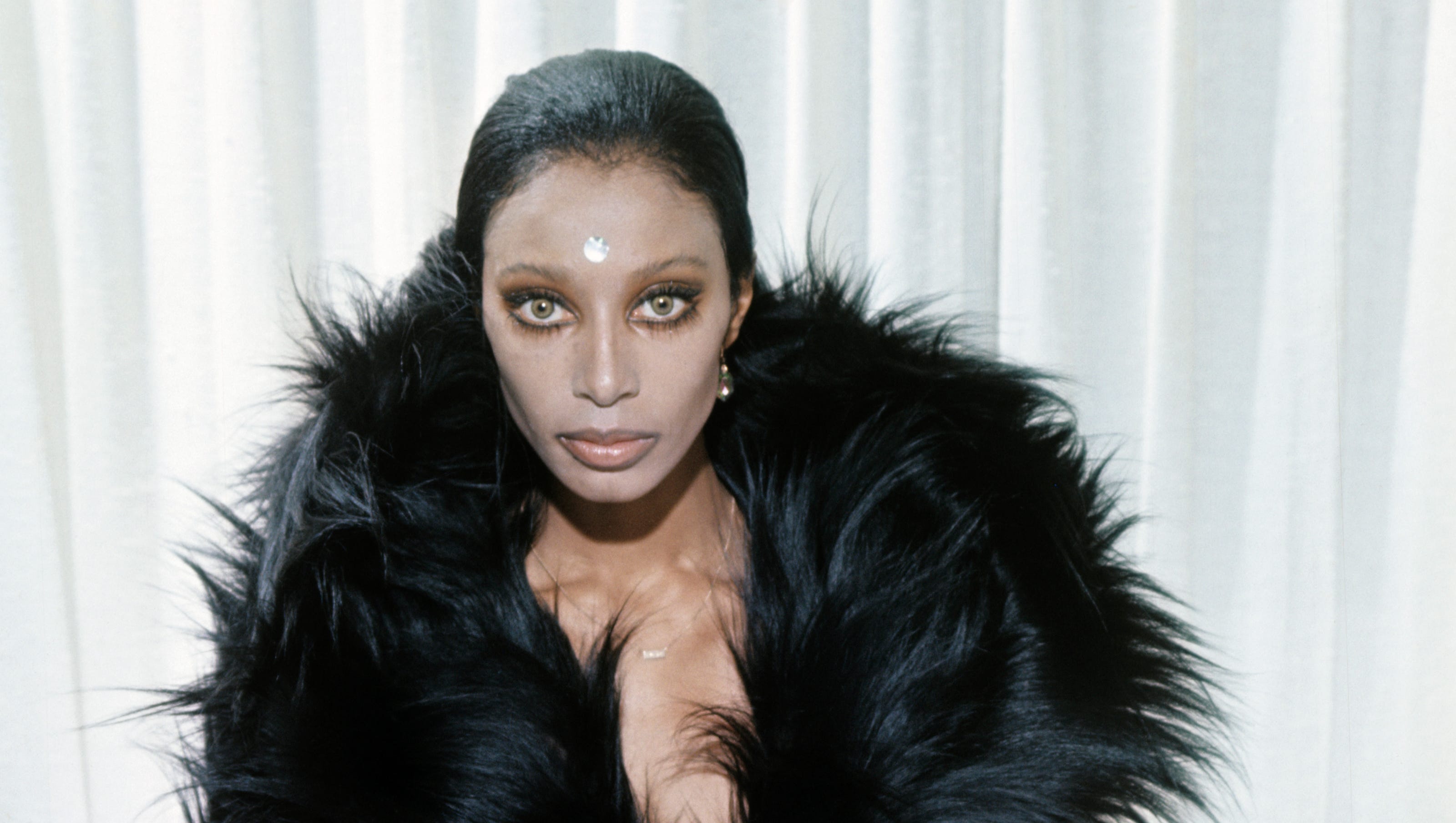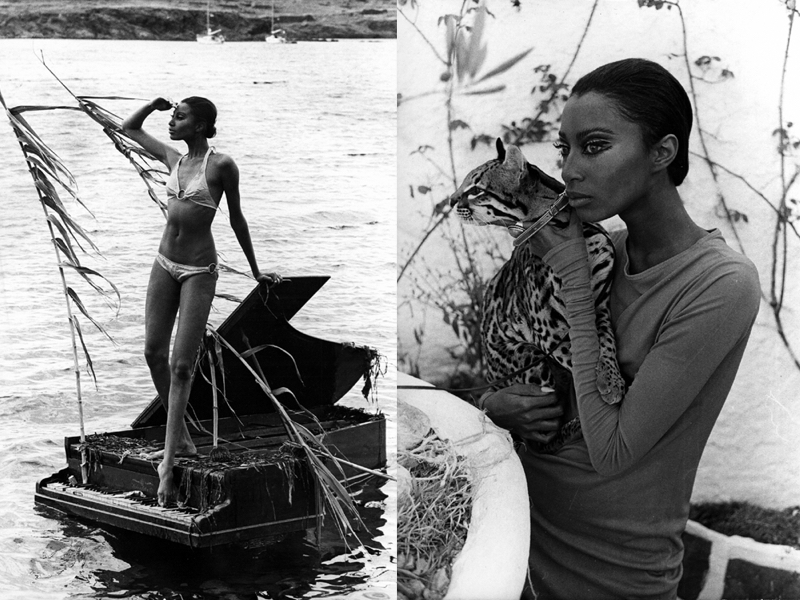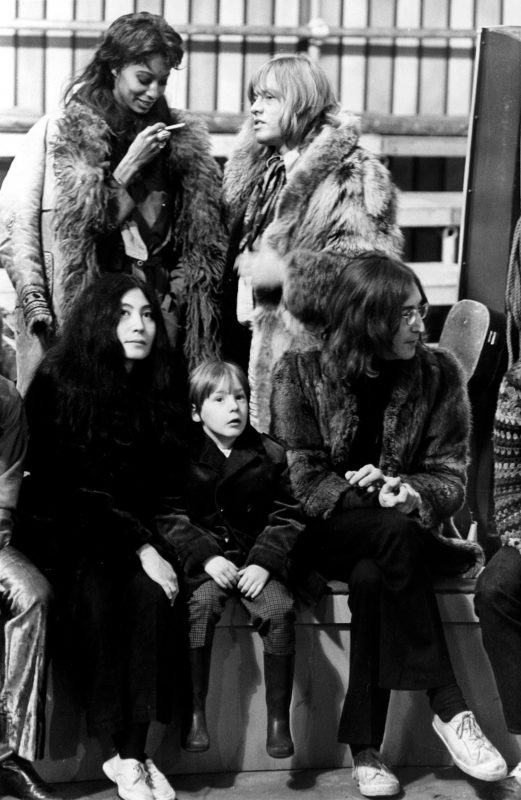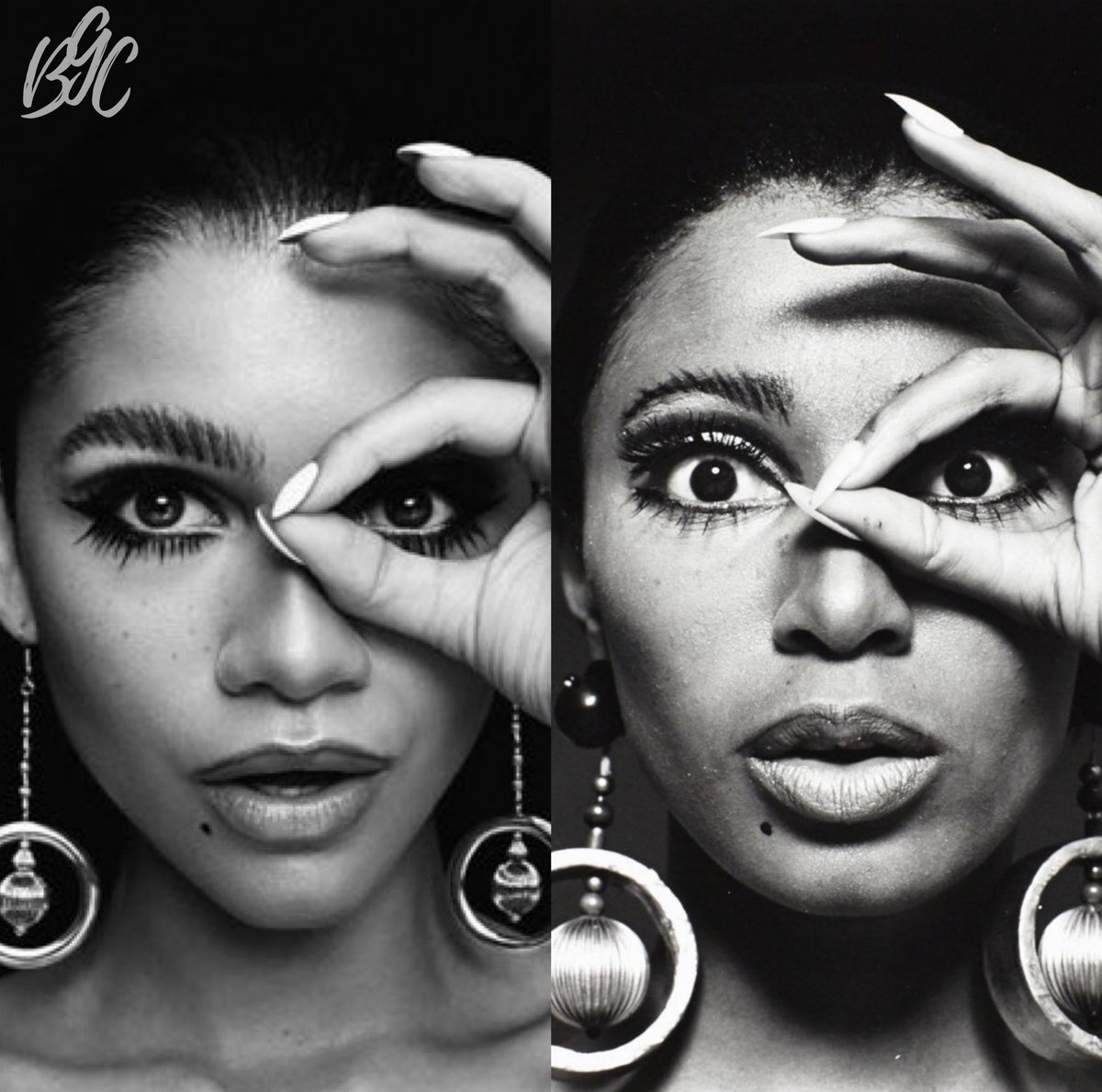Donyale Luna was the world’s first African American supermodel. Through the 60’s she starred as a magazine cover girl more than 11 times. She was the first black model to ever grace the cover of a Vogue magazine and appeared in a number of films by Andy Warhol, Antonioni’s Blow Up, and also Fellini’s Satyricon. Throughout the 1960s Luna embodied the ‘femme fatale’ as she became the muse for the most influential and dangerous artists of the decade in fashion, film, music and art.

She became the muse of choice for fashion photographers Richard Avedon, David Bailey, The Rolling Stones, and even surrealist Dali. Salvador Dali deemed Donyale Luna “The reincarnation of Neferititi”
Throughout the turbulent 60’s Luna found herself smack bang in the centre of the most happening scenes. She rolled with Miles Davis, The Black Panthers, the Warhol Factory, grooved through London’s Swinging 60’s.
Just like the song she is seen dancing to in Andy Warhol’s 1966 film ‘Camp’ she was truly “In With the In Crowd”. If ever a human was the personify the ‘femme fatale’, it was Luna.
A Dreamer and a Fantasist
Donyale Luna was born Peggy Ann Freeman in Detroit in 1945, she was the middle daughter of three children: very bright, her life revolved around school, church and local theatre productions.
Her grandparents moved from Georgia to Detroit after slavery was abolished in 1833, in what has become known as ‘The Great Migration’, as former plantation slaves sought equal rights and opportunities in the big industrialised cities of the north. Her father worked at the Ford manufacturing plant while her mother acted as a secretary for the Young Women’s Christian Association.
The young beauty was a dreamer and a fantasist who invented her alter ego, Donyale Luna, while at drama school, as part of her own self-driven makeover. As a teenager she began working as an actress after school hours, doing small parts in Detroit’s repertory theatres.

Donyale’s father was an abusive alcoholic. He was shot dead by her mother when she was just 18. Her mother encouraged her to become a nurse, but Donyale had other ideas and wanted to pursue a life as an actor.
A relative once described her as being “a very weird child, even from birth, living in a wonderland, a dream.”
Donyale Luna created her own dream. She made up a story to hide her painful upbringing, denied the reality revealed on her birth certificate and claimed that her biological father’s last name was Luna, and her mother was Mexican. Her grandmother became an Irishwoman who married a black interior decorator.
And so the stage was set for this extraordinarily beautiful and troubled woman, whose created identity helped to bring her fame and fortune and all of the trappings that came with those things.
After her mother shot her father to death, the pain of this family catastrophe must have mixed uneasily with being an object of rarification.
The Big Apple
In 1963, the fashion photographer David McCabe was visiting Detroit on assignment when, outside the city’s famous Fisher Building, he spotted Luna – already nearly 6ft tall and with her trademark willowy frame – in her plaid Catholic-school uniform on her way to a rehearsal.
As he tells it, he felt compelled to let her know that if she was ever interested in modelling, she should come to Manhattan and he would help her.
By her 19th birthday, a year later, she had decided to move to New York. She packed a case and shortly after arrived in the ‘Big Apple’.
It was incredibly brave at just 19, to leave home for Manhattan at such a turbulent point in history, with no clear plans or steady income – just a telephone number hastily written down by a stranger. As a girl of colour at that time, simply believing in her own worth and following her true calling were great revolutionary acts.
This was the autumn of 1964, just months after the Civil Rights Act was passed – legally prohibiting racial discrimination for the first time in American history – and the coming years would see the assassination of Martin Luther King, the race riots that would devastate her home city and the founding of the Black Panthers. With whom she would later come to associate.
There were virtually no modelling opportunities for non-white faces anywhere other than dedicated African-American publications such as Ebony.
Luckily, as soon as she called him, McCabe made good on his promise, taking her to meet a host of fashion editors and introducing her to the famed Richard Avedon.
In a letter she wrote to Mary Ann, her childhood friend, just after she moved, it said:
“New York is a dream… a man danced me down Fifth Avenue, and all up and down Broadway men were eyeing and whistling at me… As soon as possible I’ll send you a picture of the new me. I’ll be on top of the world if it takes every breath I have, every muscle of my skinny body. I feel it, I know it. I’ll be some kind of star real soon. Real soon.”
She was right. In photographs of cosmic power, or hip playfulness, Donyale Luna reimagined the world and her place within it.
Space-age Hyperbole

Within a few months, Luna started working with legendary photographer Avedon, and he photographed her for Harpers Bazaar magazine editorials alongside the likes of musician Bob Dylan and a young and wide-eyed Jean Shrimpton.
Meanwhile, the white and powerful predictably fetishised Donyale’s Indigenous-Mexican, Indonesian, Irish and African descent. Alongside space-age mini-dresses and metallic gowns, Donyale, in films and shoots, was cast as the ‘exotic beauty’ in cloaks, in mesh, in turbans. She wore green contact lenses and feigned a weird foreign accent.
With her talent for visual drama, extravagantly large eyes, elastic, almost extra-terrestrial limbs, America’s greatest black beauty had arrived.
But was she black? The Civil Rights movement wanted her to be blacker. Overnight, she became the ‘girl du jour’ – with newspapers across the country declaring her the first black star model.
She was something the world had never seen before. The supposedly forward-facing worlds of fashion and art, falling back on antiquity, swathed her in hyperbole. “The strength of a Masai warrior,” wrote Harper’s Bazaar. The leading fashion magazine first presented Donyale as human artwork, painting over her offending ‘Negro’ flesh, mounting her on their cover in a ladylike, paler-skinned sketch.
Outside Avedon’s studio, she fell in with the beautiful crowd. It was an era in which she joined the late-night Motown parties hosted by Sammy Davis Jr, dancing with German model Veruschka, and attending dinners given by Miles Davis at his Brownstone – one can simultaneously feel how clearly she belonged there but also how ahead of her time she was.
As the civil rights movement gathered pace, so too did society’s fascination with the “exotic” and “alien”. The world was in the middle of a cultural revolution, and Luna was on the front lines of the Swinging ’60s. Almost against her own will, she became a symbol.
The Luna Year
A year after arriving she was working with Warhol, Fellini and Avedon, and hanging out with Miles Davis and James Earl Jones. “I started at the top,” she said.
From all accounts, her rise was meteoric. A sketch of her appeared on the cover of Harper’s Bazaar in 1965, and Richard Avedon signed an exclusive contract to photograph her.
In the mid-sixties, “the magazine world really wasn’t ready for photographing beautiful black women,” McCabe said.
Luna’s first major cover, for Harper’s Bazaar in 1965, was a sketch in which her racial identity remained ambiguous. Luna’s face, most notably her lips and nose, are also obscured on her British Vogue cover, also somewhat hiding her race.

By the spring, she was firmly within the galaxy of stars who orbited Andy Warhol’s Factory – one of the only two African-American girls to be part of that world.
During the late 1960s Luna appeared in several films produced by Andy Warhol. These included Screen Test: Donyale Luna (1964), Camp (1965), and Donyale Luna (1967), a 33-minute colour film in which the model starred as Snow White.
Warhol was truly the man who sold the world. He captured her electric beauty in his Polaroids and 16mm film titled “Screen Test”, seen here illuminating Times Square, he was also inspired by her vision.
She contributed to many of his projects, including the film Camp, Warhol’s 1965 satire of his own world, in which she dances in a backless dress and fur stole to The Ramsey Lewis Trio’s hit The ‘In’ Crowd.
Time Magazine published an article about her, titled ‘The Luna Year‘. The article already revealed the trouble she was already beginning to encounter.
“A month after hitting New York, she married a young actor, divorced him after ten months, and now will not even give his name. “I love New York,” she says. “But there were bad things. People were on drugs or hung up on pot. There was homosexuality and lesbianism and people who liked to hurt.”
Unhappy with that world but unwilling to give it all up and head back to Detroit, she fled to London and Paris.
Tumultuous Times
The 60’s were also instrumental in changing the way society saw people of colour. To a large extent, Caucasian models were the norm and there was little diversity to be seen in the industry, but during this era of revolution and love, women of colour began to get the recognition they deserved.
Boyfriends included actors Terence Stamp, Klaus Kinski, as well as ‘genius junkies’ Miles Davis and Brian Jones from The Rolling Stones.
Donyale’s rise in fashion in NYC was not without incident. These were the tumultuous Civil Rights Movement years. And prejudice was never far away. On the one hand, people longed for her to become a symbol of the African-American resistance; a role she struggled with as someone who identified as mixed race.
On the other, Southern magazine advertisers pulled funding and readers cancelled their subscriptions when she graced Harper Bazaar’s pages – with Avedon eventually told to stop photographing her because of the backlash.
Southern companies were repulsed seeing a black model get so much adulation and withdrew their advertising revenue. When her contract ended, Harper’s Bazaar owner William Randolph Hearst forbade Richard Avedon from photographing Donyale for Harper’s ever again.
Avedon remembered Donyale with regretful admiration, “a girl of stunning magnetism and beauty.”
There’s no doubt, however, that she shared the highest message in Martin Luther King’s “I have a dream” speech, where she also found inspiration for daughter’s name. But in the end, no matter what she did, in America she was always going to be limited by the colour of her skin.
So she made another leap – this time to Europe, where discrimination was less prevalent.
An Otherworldly Mirage

Donyale moved to London and her career as a human artwork flourished, for a while. In 1966, she became the first black woman on the cover of British Vogue, photographed by David Bailey.
In this seminal shot, strangely lost from the canon of the Swinging Sixties, Bailey constructs a curiously seductive evasion of blackness. One eye obscured, Donyale is both so much more and less than a person; a fleshly ornament of filigree and caramel.
Model Pat Cleveland reported to The Telegraph that when Donyale walked into London restaurants, people stopped eating, stood up and applauded.
“She was like a mirage… or a fantasy.” Jackie Kennedy was hypnotised by Donyale, in a nightclub, walking up to her and murmuring, “You are very beautiful.”
December 1965 was the London of the “Youth-quake” – a world of Beatlemania, Vidal Sassoon bobs and Mary Quant miniskirts.
Again, she immediately became part of the scene. She was always drawn to radical creatives and vice versa, appearing in films such as Blow-Up, Antonioni’s 1966 satire of the ‘enfants terribles’ of fashion photography, which opens with her being shot on a rooftop in east London.
By 1968 she was playing an assistant to a fire-eater in The Rolling Stones Rock and Roll Circus, the period when she was rumoured to be involved with Brian Jones.
It is surreal to watch her move in these motion pictures; it’s as if she’s vibrating at a different frequency from those around her, with an otherworldly quality to her beauty.
Donyale tellingly described her experience with LSD as, “…a reminder that her that she was capable of loving and being loved.”
She was swiftly, however, introduced to more damaging drugs and stellar company containing those with psychological problems of their own.
Creature of Contrasts
On a professional level, her first real break came just after she arrived in the UK. In March of 1966 she became the first model of colour to grace the cover of Vogue in a shoot with David Bailey, wearing a Chloé dress and dramatic gold Mimi de N earrings.
Inspired by Picasso’s ocular-centric portraits, only a single heavily lined eye is visible through her fingers, which form a V for Vogue.
Inside the magazine, she is on display in all her glory, posing in the spring fashions from Paris alongside fellow models Moyra Swan and Peggy Moffitt: printed silk tunics from Christian Dior; mod shifts by Pierre Cardin; a glittering silver dress from Yves Saint Laurent.
Vogue editor Beatrix Miller, later on, said of her decision to put Luna in the magazine:
“She happens to be a marvellous shape – angular and immensely tall and strange. She has a kind of bite and personality.”
Overnight, she became an international celebrity – not to mention one of the most in-demand models in the world.
Time magazine dubbed 1966 the Luna Year. “She is a creature of contrasts,” the magazine wrote. “One minute sophisticated, the next fawnlike, now exotic and faraway, now a gamine from around the corner.”
That Spring, Paris Match had 11 different photographers shoot their vision of Luna. It’s telling that there are no two portraits in which she looks alike. Meanwhile, her chameleonic tendencies and fearless disposition extended to her work on the catwalk.
In Paris, where her success was compared to Josephine Baker’s in the 1920s, she modelled for André Courrèges, Yves Saint Laurent, Valentino and, perhaps most notably, Paco Rabanne, when he presented his 12 robes importables, made from Rhodoid discs, at the George V hotel.
She brought her own hypnotic energy to the runway, crawling like a lion, grooving to the music or suddenly freezing and making direct eye contact with journalists.
She travelled to Salvador Dalí’s home in the Catalonian village of Cadaqués, where he promptly declared her one of his muses.
Look at the photos of that trip and you will Luna cradling the baby ocelot that Dalí kept as a pet, or standing on a grand piano in the middle of a lake near his house. (The artist had rolled it in there himself.)
Most beautiful of all are the portraits of her in a cream gown, with Dalí sketching directly on to the fabric. In the end, it was those sorts of partnerships that fulfilled her.
“I never planned to be a model when I was in Detroit,” she told a reporter in 1966. “I wanted to be a starving actress in New York.”

Dark Beauty
At the close of the 1960s, she moved to Rome for a part in Fellini’s Satyricon (1969) where she portrayed the witch Oenothea and, later, Carmelo Bene’s in Salomè (1972).
Fantasy creates new worlds but also removes us from the burden of being human. Donyale played with her myth, allegedly telling friends, when they asked about her heritage, “I’m from the moon, darling,” she would reply.
But walking on the moon is a lonely business. The images Luna created rival – perhaps even triumph over – those of celebrated Sixties’ beauties; mainly blonde, white women like Marianne Faithful, Jane Birkin, Jane Asher, Twiggy.
It was during this period that she met Luigi Cazzaniga, an up-and-coming photographer and the twin soul who shared her vision.
The two of them fell in love, indulged their creativity and travelled the world. In one of their many shoots together, Luigi photographed her for Playboy as characters of her own devising – as an angel soaring over the Los Angeles skyline or as a mermaid perched on a rock by the Pacific Ocean.
Donyale Luna was married, engaged or romantically involved many times, like to Austrian-born Swiss actor Maximilian Schell and in 1969 with German actor Klaus Kinski. This relationship ended when Kinski asked her entourage to leave his house in Rome: he was concerned that their drug use could damage his career. Another one of her liaisons was with Rolling Stone Brian Jones.
“Dark beauty is a wonderland – for those who do not have to live within it.”
The Swinging Sixties
Donyale Luna saw her heritage as a thorn in her side. She was known to wear blond wigs and obvious green contact lenses to present a non-specific racial identity.
The journalist Judy Stone wrote a profile for the New York Times in 1968, titled “Luna, Who Dreamed of Being Snow White,” and described her as “Secretive, mysterious, contradictory, evasive, mercurial, and insistent upon her multiracial lineage — exotic, chameleon strands of Mexican, American Indian, Chinese, Irish, and, last but least escapable, Negro.”
When pressed about her African American identity and influence, Luna would bristle.

When interviewed about her groundbreaking roles in popular films, including the Rolling Stones Rock and Roll Circus, Fellini’s Satyricon, and Andy Warhol’s Camp, and asked about the fact that she was breaking down doors for her sisters to follow, Luna retorted, “If it brings about more jobs for Mexicans, Chinese, Indians, Negroes, groovy. It could be good, it could be bad. I couldn’t care less.“
By the swinging sixties, she was living it up in London and hanging with the Rolling Stones. She expressed her love for LSD, saying;
“I think it’s great. I learned that I like to live, I like to make love, I really do love somebody, I love flowers, I love the sky, I like bright colours, I like animals. [LSD] also showed me unhappy things — that I was stubborn, selfish, unreasonable, mean, that I hurt other people.”
But her ever-increasing diet of drugs, led to unprofessional behaviour, and when one added lying and stealing, it all proved too much and it started to unravel her illustrious career.
In a New York Times interview, fellow black model Beverly Johnson complained about Luna’s whacked-out mannerisms, saying;
“She doesn’t wear shoes Winter or Summer. Ask her where she’s from — Mars? She went up and down the runways on her hands and knees. She didn’t show up for bookings. She didn’t have a hard time, she made it hard for herself.”
Luna’s Legacy
Luna paved the way for such well-known names as Naomi Simms who was the First Lady of colour to grace the cover of Ladies Home Journal, as well as Life magazine. And in the 70’s Beverley Johnson became the first black model on the cover of American Vogue, later French Elle. And obviously Bethann Hardison, Iman, Naomi Campbell and all the Supermodels of colour who would follow.
Luna would marry Italian photographer Luigi Cazzaniga in 1975, and in 1977 they had a daughter, they named Dream, after the famous Martin Luther King speech.
Dream would grow up to be a dancer and raise a family of her own in France.
At the age of 33 the drug-taking finally caught up with Donyale Luna. Estranged from her husband, she died in a Rome clinic in the early hours of 17 May 1979 of an accidental heroin overdose. She left behind her 18-month-old daughter, Dream.
Despite her tremendous fame in the Sixties and Seventies, today, Donyale Luna’s groundbreaking legacy is primarily remembered by the African American community, ironically the very community she sought to distance herself from her whole life.

In 2020 Essence magazine ran a tribute to Donyale for their 50th anniversary, honoring black resilience. The 24-year-old actress Zendaya was tapped to channel some of the iconic supermodel’s most notable images.
Under the creative direction of her longtime stylist and “image architect” Law Roach, Zendaya stunned in a variety of looks all inspired by Luna, including a floor-length long sleeve knit dress by The GiGi Hunter Collection, a Miu Miu fur coat, a Fansy metal shift dress and a zebra print frock.
The Euphoria star also posed for several close-up shots sporting quintessential ’60s glam: drawn-on freckles, graphic eyeliner and larger-than-life false eyelashes.
But despite this lone coverage and perhaps because she transcends our expectations of how women might look, Donyale Luna has otherwise largely slipped from the pages of fashion history.
Looking back one can’t help but wonder how any young black woman from violent Detroit in the 1960’s, rocketing to the heights of global fashion and film, could have survived Donyale Luna’s vortex of pain and adulation.
Her life proved that “Dark beauty was indeed a wonderland – for those who do not have to live within it.”
Subscribe to FIB’s Weekly Breaking News Report for your weekly dose of music, fashion and pop culture news!







